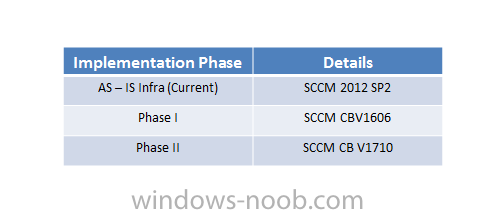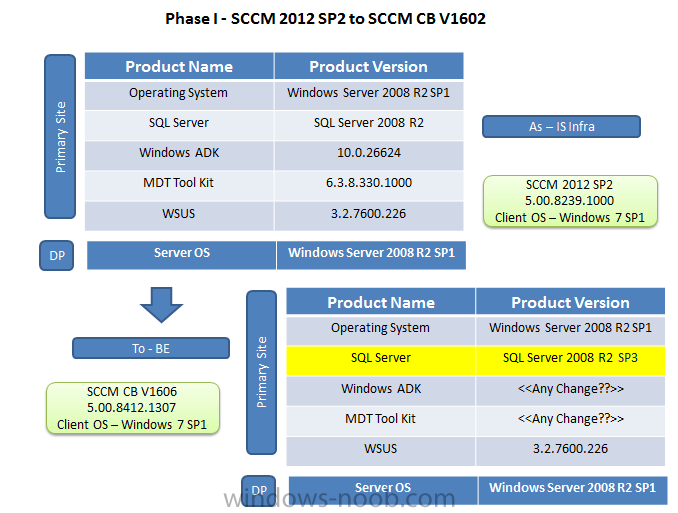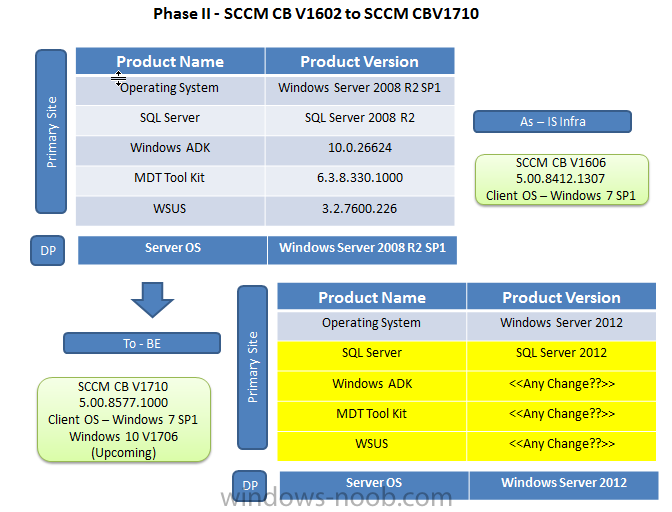
Veera
Established Members-
Posts
31 -
Joined
-
Last visited
Recent Profile Visitors
The recent visitors block is disabled and is not being shown to other users.
Veera's Achievements
Newbie (1/14)
0
Reputation
-
SCCM CB - DP, MP with High Availablity
Veera replied to Veera's topic in System Center Configuration Manager (Current Branch)
Great, Thank You We are Preferred to use the SQL Always ON Basic as HA- 8 replies
-
- sccm
- current branch
-
(and 8 more)
Tagged with:
-
SCCM CB - DP, MP with High Availablity
Veera replied to Veera's topic in System Center Configuration Manager (Current Branch)
WE do not have money to pay for SQL (Available Always AS ON). Only SQL 2017 Management Studio as STANDARD- 8 replies
-
- sccm
- current branch
-
(and 8 more)
Tagged with:
-
SCCM CB - DP, MP with High Availablity
Veera replied to Veera's topic in System Center Configuration Manager (Current Branch)
I have Plan to reduce the Workload of CPU Hence the minimum plan is to have SERVER A - Primary Site with SQL (Primary Site will be having SCCM Site Server Roles) SERVER B - All Client Facing Role So that, the CPU Utilization can be reduced accordingly.- 8 replies
-
- sccm
- current branch
-
(and 8 more)
Tagged with:
-
Veera started following SCCM CB - Implementation - System Management Container , SCCM CB - DP, MP with High Availablity , SCCM CB - Windows 10 ADK and 1 other
-
Dear Experts, I Would like to get some inputs from you Please. My Data Center is located in 2 Regions. This data center is supplying the services (Windows Server, Network., etc) At Present we are planning to perform SCCM CB Implementation with High Availability for SCCM Client Roles. In fact not for SQL (Due to Commercial items) Single Standalone Primary Site is fair enough for the environment. However, We would like to reduce the usage of SQL Server, and make the Client facing roles with HA. Hence your inputs would be helpful for us Data Center Region A: Server 1 - SCCM Site Server - A Primary Site with Roles (Component Server, Site Server, Site System, Reporting Service Point, Other Non Client Facing Roles) Server 2 - SCCM Site System - Client Facing Roles (Management Point, Software Update Point/WSUS, Distribution Point (With WDS/PXE OSD Capabilties) Data Center Region B: Server 3 - SCCM Site System - Client Facing Roles (Management Point, Software Update Point/WSUS, Distribution Point (WithOut WDS/PXE OSD Capabilties) So all Client facing role, will be working with HA Option. However, PXE Boot for OSD will work only with SERVER 2 from WDS (Which respond to the Client during the OS Imaging) - To make this happen I need to mention the IP Details of WDS Server (Server 2 from Region A) in the DHCP Scope. Am I correct? The reason, I do not preferred to give the SERVER 3 (From Region B)as WDS Role with PXE, which we do not need to give the multiple entries with DHCP Scope (Option 66, 67) for OSD Please suggest, if this is looks good for an organization. The Ultimate goal is to reduce the SQL CPU Utilization.
- 8 replies
-
- sccm
- current branch
-
(and 8 more)
Tagged with:
-
SCCM CB - Windows 10 ADK
Veera replied to Veera's topic in System Center Configuration Manager (Current Branch)
Thank You for your support.. -
SCCM CB - Windows 10 ADK
Veera replied to Veera's topic in System Center Configuration Manager (Current Branch)
You are rite. My Requirement here : With new Server (SCCM CB) we will be using it for Both Windows 7 and Windows 10. Windows 10 for sure, will be going with most recent release (V 1803..) We may still have many OS imaging with Windows 7 as well., also win 7 to win 10 upgrade. If I use, SCCM CB V1710 - I can Perform both OS Imaging *Win 7 and Win 10* Rite. In fact, We are using the boot image (Custom made) -
Dear Experts, I Would like to take an advice from you all for ADK are talking about ADK: Would like to get few points here At Present, I am having SCCM 2012 SP2 with Windows 7 with ADK *10.0.0.26624* Assume the Site Code : ABC Now the Plan is to do side by Side migration with SCCM CB V1702 and Upgrade to SCCM CB V1710 and this is to support Windows 10. Site Code : DEF Before I install windows 10, I will be moving all the clients from Site Code : ABC to DEF I will be having all my Existing Client move from *Windows 7 Machines* to DEF Site In the New Environment, Will be Managing both windows 7 and windows 10 1. Application Management (Windows 7 and Windows 10) 2. Patch Management *Windows 7, 10* 3. OS Imaging *Windows 7, Windows 10* I Would like to make my environment to be stable with both OS. Please let me know which ADK Version is needed in my Environment for Windows 10 Operating System I Will be having 1. Windows 10 LTSB 2. Windows 10 Enterprise With Version 1803 3. Also Windows 7 SP1 Which ADK Version, I Should have in my Environment *DEF Site Code* After all successful, Migration will be moving out completely from the Site Code : ABC
-
Dear Experts, Very Shortly - I will be having SCCM CB in my environment. I would like to get an advice/inputs from you to perform the Windows 10 Deployment Scenario's. Would like to get an advice, what are the topics - I should cover for Windows 10 Readiness with SCCM CB Environment My Organization preferred to perform the Management in the same way which I am doing for Windows 7. However, I would like to give some value added proposal's Any recommendations from you Experts?
-
Dear Admin, Sorry if any questions are wrong. I have been managing SCCM - But this Migration is 1st time, that we are doing which the existing version installed by 3rd Party PPL. Hence, it is require to get some advice from experts like you. At Present, Upgrade seems to be more complicated with lengthy process. Hence, it is Planned to Install Complete New Environment with Existing Production DC (With Different Site Code) I hope, We can have Multiple Environment of SCCM with in the same container (System Management), However the Site Code/Server Name should not be the same. Is that Correct? So the Plan as follows: 1. Performing the SCCM CB Environment 2. Slowly moving all Clients from One Domain to Other Domain. Current Infrastructure: SCCM 2012 SP2 with Windows 7 Clients (Managing – Application, Patch, Operating System Deployment) This is running on Windows Server 2008 with SQL 2008 Required Infrastructure: It is required to Manage Windows 10 Clients, Windows 7 Operating System (Application, Patch, OS Deployment) After being and hearing more responses from our Engineer’s/Experts. It is planned to progress the Green Field Implementation 1. Windows Server 2016 2. SQL Server 2014 or SQL Server 2016 3. Windows 10 ADK with Version ADK 1709 - 10.1.16299 4. System Center Configuration Manager V1710 New Implementation along with Distribution Point 5. Making the Environment with Complete Readiness for all Application Source, OSD Task Sequences, Software Updates., etc., This New Infra will be completely ready with supporting all contents. IP Assignment: We are already having the Boundary Groups, which is based on the IP Range with Region wise in the OLD Environment. New Environment – Client Movement from Old Infrastructure: Let us consider we have the IP Range called 192.168.1.1 to 192.168.1.254 is active and supplying the service with Windows 7 Client OS on Old Infrastructure (SCCM 2012 SP2) Now, the New Infrastructure is ready with all sources (SCCM CB V1710) – If the Client IP Range, Boundary Settings for Site assignment is getting moved from Old Infra to New Infra By Using Automatic Site Client Push Installation 1. SCCM Agent Will get install/upgrade with Version CBV1710 2. Since the IP Range, Boundary Group is allocated with New Environment All the Deployments will get started to run on new Environment. By performing this activity 1. All Windows 7 Clients will be running with SCCM CBV1710 Agent Version 2. All Windows 7 Clients will be reporting to SCCM CBV1710 Infrastructure 3. Slowly, I can prepare myself for Windows 10 Upgrade Projects. Hence, it is require to have 2 Environments in the Same System Management Container (SCCM 2012 SP2, and SCCM CB V1710). If I hold the 2 Environment with Different Site code and host name, Will that be Okay.. Please Advice!! My Sincere apologize to send the details, Personally.
- 17 replies
-
- current branch
- sccm cb
- (and 7 more)
-
Dear Experts, I would like to get an advice from you Please. You may see multiple forums from me – As my Environment is bit complicated. Environment implemented by 3rd party and handover to us as part of transformation – Which we are struggling to upgrade or proceed further. Current Infrastructure: SCCM 2012 SP2 with Windows 7 Clients (Managing – Application, Patch, Operating System Deployment) This is running on Windows Server 2008 with SQL 2008 Required Infrastructure: It is required to Manage Windows 10 Clients, Windows 7 Operating System (Application, Patch, OS Deployment) After being and hearing more responses from our Engineer’s/Experts. It is planned to progress the Green Field Implementation 1. Windows Server 2016 2. SQL Server 2014 or SQL Server 2016 3. Windows 10 ADK with Version ADK 1709 - 10.1.16299 4. System Center Configuration Manager V1710 New Implementation along with Distribution Point 5. Making the Environment with Complete Readiness for all Application Source, OSD Task Sequences, Software Updates., etc., This New Infra will be completely ready with supporting all contents. IP Assignment: We are already having the Boundary Groups, which is based on the IP Range with Region wise in the OLD Environment. New Environment – Client Movement from Old Infrastructure: Let us consider we have the IP Range called 192.168.1.1 to 192.168.1.254 is active and supplying the service with Windows 7 Client OS on Old Infrastructure (SCCM 2012 SP2) Now, the New Infrastructure is ready with all sources (SCCM CB V1710) – If the Client IP Range, Boundary Settings for Site assignment is getting moved from Old Infra to New Infra By Using Automatic Site Client Push Installation 1. SCCM Agent Will get install/upgrade with Version CBV1710 2. Since the IP Range, Boundary Group is allocated with New Environment All the Deployments will get started to run on new Environment. By performing this activity 1. All Windows 7 Clients will be running with SCCM CBV1710 Agent Version 2. All Windows 7 Clients will be reporting to SCCM CBV1710 Infrastructure 3. Slowly, I can prepare myself for Windows 10 Upgrade Projects. Hence, it is require to have 2 Environments in the Same System Management Container (SCCM 2012 SP2, and SCCM CB V1710). If I hold the 2 Environment with Different Site code and host name, Will that be Okay.. Please Advice!! My Sincere apologize to have separate post. Earlier was discussed for the Migration (With in the same server)., but now we preferred to install the SCCM CB V1710 Infra with new server *Windows 2016 & SQL 2016 * and move all the Clients to the new Infrastructure.
-
- system management container
- sccm cb
- (and 7 more)
-
Dear Admin, However, Will be performing the Green Field Implementation of SCCM CB on Existing PROD Domain Controller. If I am using Different Site code, Different Host Name for SCCM CB - Is that makes any impact on Existing System Management Container Please.
- 17 replies
-
- current branch
- sccm cb
- (and 7 more)
-
Absolutely, You are rite. Based on your approach, rather than going with Migration, can go for the new implementation and also manage both OS Versions (Windows 7 and Windows 10) Slightly, I can move all the Existing Clients from Old Infrastructure to New Infrastructure I will also think in this aspect. AS-Infra: SCCM 2012 SP2 with OSD, Application Deployment, Patch Management for Windows 7 SP1. With Single Standalone Primary Site and SQL On Same Server SCCM 2012 SP2 is installed with Windows Server 2008 SP1 STD and SQL 2008 STD Windows 10 ADK - 10.0.26624 Distribution Points - 20 + Across All location With Windows Server 2008 SP1 Standard SCCM Infra Site Code : 123 To-BE Infra: Single Standalone Primary Site with Operating System - Windows Server 2016 SQL Server - SQL Server 2014 SP2 ADK - Windows 10 ADK to Support (Version : 10.1.162990) for Windows 10 V1709 Environment System Center Configuration Manager Baseline Version - SCCM CB V1710 (Site Code : 456) Now, I will be having the Infrastructure with SCCM 2012 SP2 (Which is supporting for Windows 7) and SCCM CB V1709 (To Support both Windows 7 and Windows 10 Operating System) Let us assume that, Do I get chance to move all the Clients from SCCM 2012 SP2 to SCCM CB V1710 (Which is from Site Code: 123 to 456) Based on this, I can migrate all the Existing Windows 7 Client Operating System (Site Code : 123 to New Infra Site Code : 456) I can use the Option "Client Push Installation" account and also the Boundary Group for Site Assignment. Do you think, Is this Okay?
- 7 replies
-
- system center configuration manager
- sccm 2012
- (and 7 more)
-
Dear Garth, It is because of internal Political reason that I do not have option to upgrade the OS and SQL at this Point of time. However, If you Validate my Steps., as follows (Will be helpful) Also Requesting you to add if any items/missing from my end. As - IS Infra: SCCM 2012 SP2 with OSD, Application Deployment, Patch Management for Windows 7 SP1. With Single Standalone Primary Site and SQL On Same Server SCCM 2012 SP2 is installed with Windows Server 2008 SP1 STD and SQL 2008 STD Windows 10 ADK - 10.0.26624 Distribution Points - 20 + Across All location With Windows Server 2008 SP1 Standard Planned Infra: We are looking further to upgrade the Operating System (Client OS) from Windows 7 to Windows 10 V1709 In order to that, We need to upgrade the SCCM Infrastructure. Hence, As per the Plan Phase I: SCCM 2012 SP2 to SCCM CB V1606 Steps : 1. Retaining Windows Server 2008 On Primary Site and DP's 2. Performing SQL SP3 Update on SQL 2008 STD 3. Performing SCCM Upgrade from SCCM 2012 SP2 to SCCM CB V1606 using Baseline version 4.Installation of SCCM Client on all end Points Now the Infrastructure will be upgraded from SCCM 2012 SP2 to SCCM CB V1606 As per the Plan Phase II: (This is to Support both Windows 7 and Windows 10 V1709 Client Operating System) SCCM CB V1606 to SCCM CB V1710 1. Upgrading the Primary Site Operating System from Windows Server 2008 SP1 to Windows Server 2012 2. Upgrading the SQL Server from SQL 2008 SP3 to SQL 2012 SP4 3. Uninstalling the OLD Windows 10 ADK and Install the new Windows 10 ADK (10.1.16299) 4. Uninstalling the WSUS/SUP Role and Reinstalling it again on Windows Server 2012 5. Running the CB Upgrade from SCCM CBV1606 to CBV1710 6. Installing SCCM Client CB V1710 on Windows 7 SP1 Computers 7. Preparation of Windows 10 Operating System in the Environment Finally the Infrastructure with Windows 7 and Windows 10 OS, for Application Management, Patch Management, OS Deployment, Imaging., etc., I Would like to get the inputs from you Please.
- 7 replies
-
- system center configuration manager
- sccm 2012
- (and 7 more)
-
My Apologize, Let me Explain.. As - IS Infra: SCCM 2012 SP2 with OSD, Application Deployment, Patch Management for Windows 7 SP1. With Single Standalone Primary Site and SQL On Same Server SCCM 2012 SP2 is installed with Windows Server 2008 SP1 STD and SQL 2008 STD Windows 10 ADK - 10.0.26624 Distribution Points - 20 + Across All location With Windows Server 2008 SP1 Standard Planned Infra: We are looking further to upgrade the Operating System (Client OS) from Windows 7 to Windows 10 V1709 In order to that, We need to upgrade the SCCM Infrastructure. Hence, As per the Plan Phase I: SCCM 2012 SP2 to SCCM CB V1606 Steps : 1. Retaining Windows Server 2008 On Primary Site and DP's 2. Performing SQL SP3 Update on SQL 2008 STD 3. Performing SCCM Upgrade from SCCM 2012 SP2 to SCCM CB V1606 using Baseline version 4.Installation of SCCM Client on all end Points Now the Infrastructure will be upgraded from SCCM 2012 SP2 to SCCM CB V1606 As per the Plan Phase II: (This is to Support both Windows 7 and Windows 10 V1709 Client Operating System) SCCM CB V1606 to SCCM CB V1710 1. Upgrading the Primary Site Operating System from Windows Server 2008 SP1 to Windows Server 2012 2. Upgrading the SQL Server from SQL 2008 SP3 to SQL 2012 SP4 3. Uninstalling the OLD Windows 10 ADK and Install the new Windows 10 ADK (10.1.16299) 4. Uninstalling the WSUS/SUP Role and Reinstalling it again on Windows Server 2012 5. Running the CB Upgrade from SCCM CBV1606 to CBV1710 6. Installing SCCM Client CB V1710 on Windows 7 SP1 Computers 7. Preparation of Windows 10 Operating System in the Environment Finally the Infrastructure with Windows 7 and Windows 10 OS, for Application Management, Patch Management, OS Deployment, Imaging., etc., I Would like to get the inputs from you Please.
- 7 replies
-
- system center configuration manager
- sccm 2012
- (and 7 more)
-
- 7 replies
-
- system center configuration manager
- sccm 2012
- (and 7 more)




